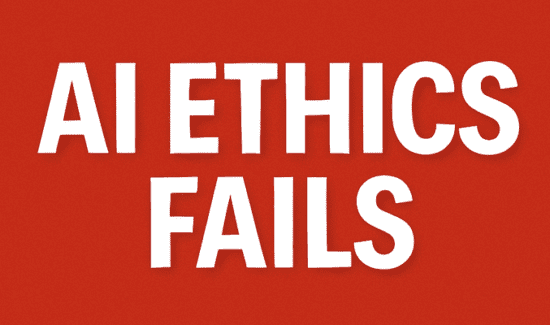An Introduction to AI Policy: Transparency in AI Deployment

Solutions Review Executive Editor Tim King offers an introduction to AI policy through the lens of transparency in AI deployment.
Transparency in AI deployment is not a virtue signal—it is a prerequisite for trust, accountability, and sustainable adoption. In an era where AI systems are increasingly embedded in decisions that affect livelihoods, autonomy, and human agency, a firm’s ability to communicate clearly how and why AI is used becomes a strategic imperative, not a compliance checkbox. The opacity that once shielded proprietary algorithms under the guise of competitive advantage is now a liability. Stakeholders—from employees and regulators to customers and investors—demand visibility into the logic, limitations, and potential consequences of AI-driven decisions. And rightly so.
When a machine recommends layoffs, optimizes workloads to the point of burnout, or denies opportunities via algorithmic filtering, the burden of justification is not on the affected human—it’s on the firm deploying the system.
Important: AI Won’t Replace You, But Lack of Soft Skills Might – Get Report
An Introduction to AI Policy: Transparency in AI Deployment
Transparency must operate on multiple levels:
Operational Transparency: Exposing the How, Where & Who of AI Usage
Operational transparency is the first and most visible layer of AI disclosure. It concerns how AI systems are embedded into workflows, who is responsible for managing them, and where decision-making has been automated or augmented. This is the “boots on the ground” layer of transparency—and it’s where most AI initiatives fail.
Firms must clearly communicate which business processes are influenced or controlled by AI, especially where the stakes are high: hiring, firing, pricing, promotion, surveillance, benefits eligibility, etc. It’s not enough to say, “We use AI in recruitment.” Firms need to say how AI ranks candidates, which criteria are weighted, whether a human can override the decision, and how individuals can contest or appeal those decisions. Employees must also know whether their work is being monitored by AI (e.g., productivity tracking, keylogging, sentiment analysis) and what data is being collected, for what purpose, and with what safeguards.
Good operational transparency also assigns clear responsibility. If a system malfunctions or causes harm, who owns that problem? Too many firms deploy AI as though it’s a ghost in the machine—blameless, ownerless, above reproach. Accountability must be explicit, with designated system stewards who understand both the technical and human dimensions of the deployment. This is not just about compliance; it’s about protecting your internal social contract.
Finally, operational transparency enables collaboration across silos. If legal, HR, IT, and operations all understand where and how AI is being used, they can intervene more intelligently, flag ethical red lines early, and ensure cross-functional resilience. AI is not an IT deployment—it’s an organizational transformation, and transparency is what gets everyone reading from the same playbook.
Model Transparency: Understanding the What & Why Behind Algorithmic Behavior
Model transparency deals with the core architecture of the AI system itself—what it’s doing under the hood. This is the layer where explainability, interpretability, and auditability live. It answers questions like: What kind of model is being used (e.g., random forest, transformer, deep neural network)? What data was it trained on? How is it making decisions? What are the known limitations?
For high-stakes applications—credit decisions, hiring models, predictive policing, performance evaluations—black-box models are increasingly indefensible. If you cannot explain how a model arrived at a decision, you cannot ethically or legally defend that decision. Even if the underlying mathematics are complex, firms can implement model documentation techniques like model cards, algorithmic datasheets, or explanation interfaces to make the logic understandable to non-technical stakeholders.
Critically, transparency here isn’t about full open-sourcing or giving away trade secrets. It’s about selective, contextual clarity: what inputs the model uses, what outcomes it predicts, what confidence thresholds it sets, and what kinds of errors it’s most likely to make. This helps employees and users develop a mental model of the AI—what it’s good at, when to trust it, and when to override it.
Model transparency also aids in risk forecasting. When a system begins to drift—when accuracy degrades, when bias emerges, when performance across demographics becomes inconsistent—you need instrumentation in place to catch it. Opaque models degrade silently. Transparent ones generate early warnings. That’s the difference between firefighting and foresight.
Intentional Transparency: Clarifying the Why & the Human Stakes
Intentional transparency is the most often neglected but arguably the most crucial. It’s the act of telling the truth about why you’re deploying AI in the first place. This is where ethical posturing either meets substance—or collapses.
Too many AI strategies are justified in vague terms: “efficiency,” “modernization,” “digital transformation.” These abstractions hide the real impacts on human work. If you’re using AI to eliminate 20 percent of a department’s labor hours, say so—and explain how you’re going to reskill or support the affected employees. If you’re implementing predictive scheduling software that reduces autonomy for hourly workers, acknowledge it—and show how their preferences or well-being were considered in the design process. If the goal is shareholder value at the cost of headcount, don’t sell it internally as an empowerment tool.
This level of truth-telling might feel uncomfortable, but it builds long-term trust. Workers can accept hard changes when they understand the rationale and believe the process was fair. What they won’t tolerate is the Orwellian mismatch between euphemistic AI messaging and real-world impacts on their roles and dignity.
Intentional transparency also involves engaging employees and stakeholders in the decision to deploy AI—early and often. This isn’t just for optics. Workers on the front lines have the clearest insight into the practical limitations, edge cases, and unintended consequences of automation. A strong intentional transparency strategy includes employee input as a design principle, not an afterthought. AI adoption should not be a memo; it should be a dialogue.
It goes deeper still: firms must explain the strategic rationale behind AI adoption, including what human roles are expected to change, be eliminated, or be augmented. This last point is crucial and often ignored. Too many AI rollouts are justified post hoc under vague “efficiency” or “innovation” goals, when in fact they are headcount strategies cloaked in techno-optimism. That kind of obfuscation is not only ethically suspect—it’s reputationally dangerous.
More on Transparency in AI Deployment
A human-centered AI policy begins by rejecting the false binary between opacity and security. The argument that full transparency exposes sensitive IP or creates exploitability risks is valid but incomplete. Firms must invest in selective disclosure mechanisms—like model cards, datasheets for datasets, algorithmic impact assessments, and transparency reports—that provide meaningful insight without compromising proprietary assets.
Think of it as the AI equivalent of a nutritional label: the average consumer doesn’t need to know the molecular structure of preservatives, but they do have a right to know what they’re ingesting. Similarly, workers subjected to algorithmic scheduling, surveillance, or assessment deserve a high-level understanding of the system’s scope, criteria, and redress pathways. Anything less is digital disenfranchisement.
The Contrarian View
That transparency hinders innovation—is empirically weak. In fact, we argue the opposite: transparency accelerates trust-based innovation cycles. It enables faster employee adaptation, smoother stakeholder buy-in, and more resilient systems because feedback loops are richer and failure points are visible. Closed systems tend to rot from the inside. Open ones, when structured correctly, evolve.
Moreover, as regulatory frameworks mature—see the EU AI Act, emerging U.S. AI standards, and ISO/IEC 42001—transparency is fast becoming a legal baseline. Firms that build policies around explainability, traceability, and auditability now are buying optionality and risk insurance for tomorrow. They’re future-proofing their governance stack. And crucially, they’re sending a message to their workforce: you are not being replaced blindly; you are being considered strategically.
To that end, we advocate a transparency doctrine that is not merely reactive or legalistic but proactive and narrative-driven. Every AI deployment in the enterprise should come with a story—one that articulates the purpose, the human benefit, the safeguards, and the horizon of accountability. This story should be internally distributed, externally publishable, and updated as systems evolve. Without that narrative, firms will lose the plot—literally and figuratively.
The Bottom Line
Firms should explain the strategic rationale behind AI adoption first and foremost because it’s the single most effective way to earn trust—internally from employees and stakeholders, and externally from customers, regulators, and the public.
In an environment of increasing AI skepticism, rising regulatory pressure, and widespread fear of job displacement, leading with clarity about why you’re deploying AI demonstrates both ethical maturity and strategic foresight. It shows you’re not just adopting AI because it’s trendy or because “efficiency” is a buzzword, but because you’ve considered its implications deeply—and you’re willing to be held accountable for them.
- It reduces resistance and friction. Employees fear what they don’t understand, especially when it comes to automation. When AI is introduced without context, it invites rumors, resentment, and pushback. But if you explain that AI will, for example, automate repetitive low-value tasks to free up employee bandwidth for more strategic work—and you prove it with credible plans—employees are more likely to engage with the change instead of resisting it.
- It preserves long-term reputational capital. Stakeholders are increasingly attuned to ethical and social dimensions of tech adoption. If your AI deployment leads to harm or controversy and it turns out you were vague or misleading about your intentions, the reputational damage can outweigh any short-term gain. Transparency acts as brand insurance.
- It helps surface better ideas and blind spots. When you explain your rationale clearly—“We’re deploying this AI tool to optimize supply chain decisions, reduce waste, and redirect labor toward higher-margin logistics planning”—you invite the kind of grounded feedback from domain experts and frontline workers that can improve deployment and avoid pitfalls. Transparency opens feedback loops.
- It future-proofs against regulation. Regulatory frameworks are trending toward mandatory disclosures of AI use cases and human impact assessments (see: EU AI Act, U.S. Blueprint for an AI Bill of Rights). Being transparent now gives you a head start in adapting to this coming compliance environment—and signals leadership in responsible AI governance.
As for how to deliver that transparency, it must be:
-
Proactive, not reactive: Don’t wait until someone asks why you’re using AI to explain it. Build explanation into the deployment process. Communicate it in project kickoffs, town halls, internal wikis, customer-facing documentation, and quarterly reports.
-
Layered for different audiences: Executives need to see ROI projections and strategic fit. Employees want to know how their jobs will change. Customers may need assurance that their data or experience won’t be compromised. Tailor your message, but keep the core rationale consistent.
-
Narrative-driven: People respond better to stories than spreadsheets. Frame your AI initiative as part of a broader vision: “We’re using AI to increase customer satisfaction, reduce employee burnout, and stay competitive in a volatile market—here’s how we’re doing it responsibly.”
-
Linked to safeguards: Transparency without guardrails rings hollow. Don’t just say why you’re using AI—show how you’re mitigating harm, preserving jobs, enabling upskilling, or protecting user rights. This is the real difference between persuasion and propaganda.
The call to action is clear: firms must embed transparency into the DNA of their AI strategy. Not as a quarterly disclosure or a final QA step, but as a cultural standard from ideation through deployment. As you prepare to adopt AI, ask not just what it can do, but who it affects, how it does so, and why your team, your clients, and your community should trust it. Transparency is not the end goal—it is the architecture that allows every other AI value, from ethics to efficiency, to stand tall.
Note: These insights were informed through web research and generative AI tools. Solutions Review editors use a multi-prompt approach and model overlay to optimize content for relevance and utility.



